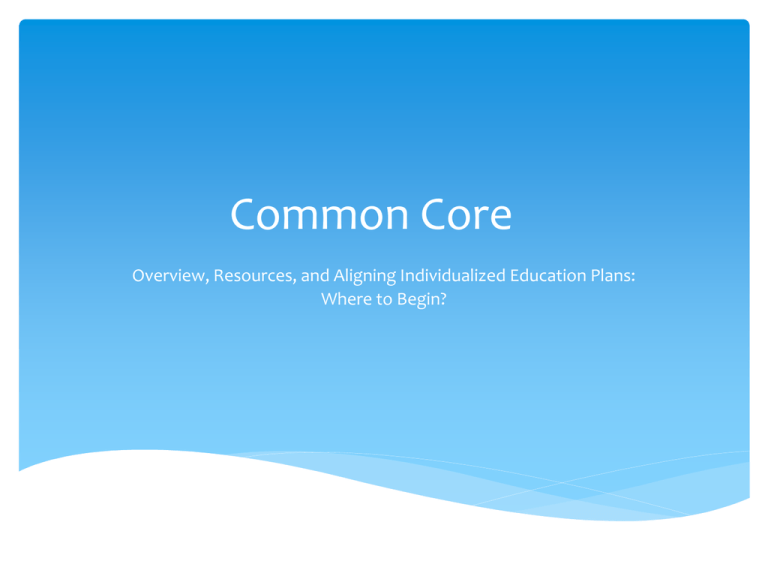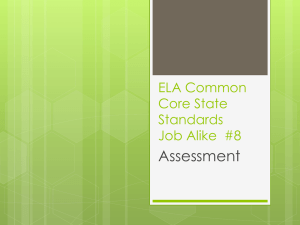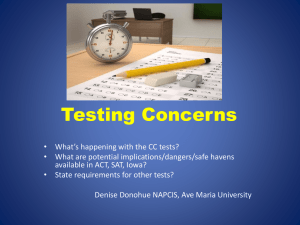Common Core: Overview, Resources & Aligning Individual
advertisement

Common Core Overview, Resources, and Aligning Individualized Education Plans: Where to Begin? Training Objectives Review Common Core State Standards • History • ELA • Math Review Common Core Resources • To help with implementation Review PARCC (Replacing ISAT) Common Core and IEP Implementation • Aligning Goals • Illinois Alternative Assessment • Illinois Essential Elements ISBE Website Training focuses on ISBE resources http://www.isbe.net/common_core/pls/default.htm Common Core Needs Assessment http://www.isbe.net/common_core/pls/level1/html/need s-asmt-basic-info.htm Illinois Adoption Common Core State Standards (CCSS) On June 24, 2010, the Illinois State Board of Education (ISBE) adopted new, more rigorous learning standards for Math and English Language Arts, known as the Common Core State Standards (CCSS). The CCSS are in addition to the Illinois Learning Standards (ILS) in Science, Social Science, Physical Development and Health, Fine Arts, Foreign Language, and Social/Emotional Learning Why New Standards? Expectations for what students must know and be able to demonstrate were different in 1997 when Illinois adopted the current standards. The new standards aim to provide clear, consistent academic benchmarks with “fewer, clearer, and higher” academic standards for essential learning and skills. The standards were developed while considering the standards of top performing countries and the strengths of current state standards. The 2010 state standards provide benchmarks for academic progress (skills and knowledge) that students should have at the conclusion of each grade level. This will allow teachers to establish the best approach to help their students meet those standards. Students and parents will clearly understand the knowledge students are expected to attain each year. CCSS Fewer, clearer, higher Internationally benchmarked 21st Century Skills Evidence‐based Implementation Rates Based on a recent common core survey, 80% of the respondents reported that their school or districts have a Common Core State Standards (CCSS) implementation plan in place. 62% of high school respondents, 85% of grade 6-8 respondents, and 84% of grades K-5 respondents reported that a CCSS implementation plan is in place. Common Core State Standards: ELA Common Core English Language Arts “Capacities of a Literate Student” • They demonstrate independence. • They build strong content knowledge. • They respond to varying demands of audience, task, purpose, and discipline. • They comprehend as well as critique. • They value evidence. • They use technology and digital media strategically and capably. • They come to understand other perspectives and cultures. Common Core State Standards: ELA How should educators focus instruction to help students develop these skills? Common Core Instructional Shifts in ELA/Literacy • Building knowledge through content-rich nonfiction and informational texts • Reading and writing grounded in evidence from text • Regular practice with complex text and its academic vocabulary ELA Common Core Strands Reading – 10 Strands Writing – 10 Strands Speaking and Listening – 6 Strands Language – 6 Strands Common Core State Standards Initiative: ELA Standards http://www.corestandards.org/ELA-Literacy ELA Standards: Reading Strand The standards establish a ―stair case of increasing complexity in what students must be able to read so that all students are ready for the demands of college-and career-level reading no later than the end of high school. The standards also require the progressive development of reading comprehension so that students advancing through the grades are able to gain more from whatever they read. Through reading a diverse array of classic and contemporary literature as well as challenging informational texts in a range of subjects, students are expected to build knowledge, gain insights, explore possibilities, and broaden their perspective. Because the standards are building blocks for successful classrooms, but recognize that teachers, school districts and states need to decide on appropriate curriculum, they intentionally do not offer a required reading list. Instead, they offer numerous sample texts to help teachers prepare for the school year and allow parents and students to know what to expect at the beginning of the year. The standards mandate certain critical types of content for all students, including classic myths and stories from around the world, foundational U.S. documents, and seminal works of literature. The standards appropriately defer the many remaining decisions about what and how to teach to states, districts, and schools. ELA Standards: Writing The ability to write logical arguments based on substantive claims, sound reasoning, and relevant evidence is a cornerstone of the writing standards, with opinion writing—a basic form of argument— extending down into the earliest grades. Student research—both short, focused projects (such as those commonly required in the workplace) and longer term in depth research —is emphasized throughout the standards but most prominently in the writing strand since a written analysis and presentation of findings is so often critical. Annotated samples of student writing accompany the standards and help establish adequate performance levels in writing arguments, informational/explanatory texts, and narratives in the various grades. ELA Standards: Speaking and Listening The standards require that students gain, evaluate, and present increasingly complex information, ideas, and evidence through listening and speaking as well as through media. An important focus of the speaking and listening standards is academic discussion in one-on-one, small group, and whole-class settings. Formal presentations are one important way such talk occurs, but so is the more informal discussion that takes place as students collaborate to answer questions, build understanding, and solve problems. ELA Standards: Language The standards expect that students will grow their vocabularies through a mix of conversations, direct instruction, and reading. The standards will help students determine word meanings, appreciate the nuances of words, and steadily expand their repertoire of words and phrases. The standards help prepare students for real life experience at college and in 21st century careers. The standards recognize that students must be able to use formal English in their writing and speaking but that they must also be able to make informed, skillful choices among the many ways to express themselves through language. Vocabulary and conventions are treated in their own strand not because skills in these areas should be handled in isolation, but because their use extends across reading, writing, speaking, and listening. Who is Responsible for Implementing Literacy Standards The Standards insist that instruction in reading, writing, speaking, listening, and language be a shared responsibility within then school. All disciplines shifting instruction to focus on Reading complex text Writing from sources Using Text Dependent Questions Teaching and Using Vocabulary Tier 2 (cite, summarize, evidence) and Tier 3 Words (text dependent: isotope, legislature) Grades 6-12: School Wide Departmental Focus on ELA Standards http://www.corestandards.org/ELA-Literacy Examples of the Progression of Learning Between Grades Reading Standards for Informational Text: Kindergarten Grade 5 Grade 8 Grade 11-12 With prompting and support, ask and answer questions about key details in a text. Quote accurately from a text when explaining what the text says explicitly and when drawing inferences from the text. Cite the textual evidence that most strongly supports an analysis of what the text says explicitly as well as inferences drawn from the text. Cite strong and thorough textual evidence to support analysis of what the text says explicitly as well as inferences drawn from the text, including determining where the text leaves matters uncertain. Taken From: http://ccss.lausd.net/sites/ccss.lausd.net/files/Module%201-Handout%201.pdf Examples of the Progression of Learning Between Grades Reading Standards Science and Technical Subjects: Grades 6-8 Grades 9-10 Grades 11-12 Cite specific textual evidence to support analysis of science and technical texts. Cite specific textual evidence to support analysis of science and technical texts, attending to the precise details of explanations or descriptions. Cite specific textual evidence to support analysis of science and technical texts, attending to important distinctions the author makes and to any gaps or inconsistencies in the account. Taken From: http://ccss.lausd.net/sites/ccss.lausd.net/files/Module%201-Handout%201.pdf ELA Resources for all Disciplines Literacy Design Collaborative http://www.literacydesigncollaborative.org/ ELA Alignment: Where to Begin ISBE Developed Documents: Quarterly Skills and Knowledge Guides http://www.isbe.net/common_core/pls/level2/html/qs k.htm Common Core State Standards: Math Common Core Mathematics Practice Standards Make sense of problems and persevere in solving them. Reason abstractly and quantitatively. Construct viable arguments & critique the reasoning of others. Model with mathematics. Use appropriate tools strategically. Attend to precision. Look for and make use of structure. Look for and express regularity in repeated reasoning. Common Core State Standards: Math How should educators focus instruction to help students develop these skills? Common Core Instructional Shifts in Mathematics • Focus strongly where the Standards focus • Coherence: think across grades, and link to major topics within grades • Rigor: in major topics pursue: conceptual understanding, procedural skill and fluency, and application with equal intensity. Common Core Math Standards: What do they look like? http://www.corestandards.org/Math/Content/introdu ction/how-to-read-the-grade-level-standards Key Shifts in Math Standards http://www.isbe.net/common_core/pls/level1/pdf/keyshifts-ccssm.pdf Math Standards The standards stress not only procedural skills, but also conceptual understanding, to make sure students are learning and absorbing the critical information they need to succeed at higher levels rather than the current practices by which many students learn enough to get by on the next test, but forget it shortly thereafter, only to review again the following year. The K-5 standards provide students with a solid foundation in whole numbers, addition, subtraction, multiplication, division, fractions and decimals--which help young students build the foundation to successfully apply more demanding math concepts and procedures, and move into applications. In kindergarten, the standards follow successful international models and recommendations from the National Research Council’s Early Math Panel report, by focusing kindergarten work on the number core: learning how numbers correspond to quantities, and learning how to put numbers together and take them apart (the beginnings of addition and subtraction). The K-5 standards build on the best state standards to provide detailed guidance to teachers on how to navigate their way through knotty topics such as fractions, negative numbers, and geometry, and do so by maintaining a continuous progression from grade to grade. Having built a strong foundation K-5, students can do hands on learning in geometry, algebra, probability and statistics. Students who have completed 7th grade and mastered the content and skills through the 7th grade will be well- prepared for algebra in grade 8. Math Standards The middle school standards are robust and provide a coherent and rich preparation for high school mathematics. The high school standards call on students to practice applying mathematical ways of thinking to real world issues and challenges; they prepare students to think and reason mathematically. The high school standards set a rigorous definition of college and career readiness, by helping students develop a depth of understanding and ability to apply mathematics to novel situations, as college students and employees regularly do. The high school standards emphasize mathematical modeling, the use of mathematics and statistics to analyze empirical situations, understand them better, and improve decisions. Common Core Resources by Grade Level Capture the Core Newsletters http://www.isbe.net/common_core/htmls/news.htm Common Core State Standards Initiative http://www.corestandards.org/the-standards EQuiP Rubrics EQuIP (Educators Evaluating the Quality of Instructional Products) is an initiative of the American Diploma Project (ADP) Network designed to identify high-quality materials aligned to the Common Core State Standards (CCSS). The objectives are two-fold: Increase the supply of high quality lessons and units aligned to the CCSS that are available to elementary, middle, and high school teachers as soon as possible; and, Build the capacity of educators to evaluate and improve the quality of instructional materials for use in their classrooms and schools. How States are Using the Rubrics Many states and districts have embraced the rubrics and review process to support their implementation of the CCSS in a variety of ways including: Guide the development of lessons and units; Evaluate existing lessons and units to identify improvements needed to align with the CCSS; Build the capacity of teachers to gain a deeper understanding of the CCSS; and, Inform vendors of criteria that will be applied in the evaluation of proposals and final products EQuiP Rubrics Rubric for Mathematics http://www.achieve.org/files/EQuIPmathrubric-06-1713.pdf Rubric for ELA http://www.achieve.org/files/EQuIP-ELArubric-06-24-13FINAL.pdf Separated by K-2 and 3-12 Common Core Checklists http://www.thecurriculumcorner.com/2012/08/18/com mon-core-checklists/ PARCC Assessment Partnership for Assessment of Readiness for College and Career PARCC Assessment Illinois, along with 22 other states, joined the Partnership for Assessment of Readiness for College and Career (PARCC) PARCC Assessment Goals 1. Create high-quality assessments 2. Build a pathway to college and career readiness for all students 3. Support educators in the classroom 4. Develop 21st century, technology-based assessments 5. Advance accountability at all levels PARCC Administration Summative/Interim PARCC will consist of four assessment components Each component will be computer delivered Two summative assessment components designed to Make “college and career readiness” and “on-track” determinations Measure the full range of standards and full performance continuum Provide data for accountability uses, including measures of growth Two Interim Generate timely information for informing instruction, interventions, and professional development during the school year In ELA/literacy, a third formative component will assess students’ speaking and listening skills PARCC Administration Summative Components Summative Assessment Components: Performance-Based Assessment (PBA) administered as close to the end of the school year as possible. The ELA/literacy PBA will focus on writing effectively when analyzing text. The mathematics PBA will focus on applying skills, concepts, and understandings to solve multi-step problems requiring abstract reasoning, precision, perseverance, and strategic use of tools End-of-Year Assessment (EOY) administered after approx. 90% of the school year. The ELA/literacy EOY will focus on reading comprehension. The mathematics EOY will be comprised of innovative, machine scorable items PARCCC Administration Interim Components Interim Assessment Components: Early Assessment designed to be an indicator of student knowledge and skills so that instruction, supports and professional development can be tailored to meet student needs Mid-Year Assessment comprised of performance-based items and tasks, with an emphasis on hard-to measure standards. PARCC Assessment: Illinois What does this mean for Illinois? Illinois will administer the ISAT in the 2013-2014 school year. The ISAT will contain CCSS items PARCC assessments will be implemented in the 20142015 school year. Refer to ISBE Roadmap for the 2013 Illinois Standards Achievement Test ELA/MATH http://www.isbe.state.il.us/assessment/pdfs/2013/isat/road map-ela-13.pdf http://www.isbe.state.il.us/assessment/pdfs/2013/isat/road map-math-13.pdf Common Core: Special Education IEP Alignment and Illinois Alternative Assessment Special Education and Common Core Why must districts reference Common Core Standards in the IEP? According to federal and state regulations annual goals must enable the student to be involved and make progress in the general education curriculum. Federal Regulation 34 CFR 300.320(a)(2)(i)(A) Definition of Individualized Education Program: (a) General. As used in this part, the term individualized education program or IEP means a written statement for each child with a disability that is developed, reviewed, and revised in a meeting in accordance with §§ 300.320 through 300.324, and that must include— (1) A statement of the child's present levels of academic achievement and functional performance, including— (i) How the child's disability affects the child's involvement and progress in the general education curriculum (i.e., the same curriculum as for nondisabled children); or (ii) For preschool children, as appropriate, how the disability affects the child's participation in appropriate activities; (2)(i) A statement of measurable annual goals, including academic and functional goals designed to— (A) Meet the child's needs that result from the child's disability to enable the child to be involved in and make progress in the general education curriculum; and (B) Meet each of the child's other educational needs that result from the child's disability; State Regulation 23 IAC 226.230(a)(I) State Regulation 23 IAC 226.230(a)(I) refers to the Content of the IEP The content of each child’s IEP shall conform to the requirements of 34 CFR 300.320. The additional requirements of this section shall also apply. a) Each IEP shall include: I) A statement of measureable annual goals that reflect consideration of the state Goals for Learning and the Illinois Learning Standards, as well as benchmarks or short-term objectives developed in accordance with the child’s present levels of educational performance Referencing Common Core When connecting a student’s IEP goals to the new CCSS for English/Language Arts and Mathematics, referencing the standard is sufficient to meet the federal requirement that the annual goals must enable the student to be involved and make progress in the general education curriculum (34 CFR 300.320(a)(2)(i)(A) and 23 IAC 226.230(a)(1)). The following are examples for referencing the CCSS in these content areas: Referencing Common Core Reading Reading, Grade 4: Foundational Skills - Fluency, Standard 4, which states: read with sufficient accuracy and fluency to support comprehension. This standard would be referenced as CC.4.RF.4. It is not required to reference the subsets that accompany the standard. http://www.corestandards.org/ELA-Literacy/RF/4 Referencing Common Core Math Mathematics, Grade 3: Number and Operations Fractions, Develop understanding of fractions as numbers, Standard 2: which states understand a fraction as a number on the number line; represent fractions on a number line diagram. This standard would be referenced as CC.3.NF.2, with no requirement for further notation for the subsets. http://www.corestandards.org/Math/Content/3/NF Aligning Common Core State Standards to the IEP Use the CCSS as a foundation, utilizing best practice at the district/building level to ensure that strategies to implement IEP goals are directly related to the CCSS. IT IS IMPORTANT to keep in mind that when a state standard is referenced in a student’s IEP goal, the standards itself is not the goal. Aligning Common Core State Standards to the IEP Within a students IEP (goals/objectives) the CCSS must align with the student’s grade level, regardless of his/her performance/instructional level. For example: An IEP student who is in the fourth grade his/her goals/objectives must be references to fourth grade CCSS, even if the student is functioning at the first grade level. Examples of Aligning CCSS with Grade Level If a fourth grade student is reading at a first grade level, the CCSS of CC.4.R.I.1 would be referenced when writing a goal about conveying details and information from a text. This could be facilitated in the general education classroom for the student through the use of accommodations and modifications. Examples of Aligning CCSS with Grade Level If an eleventh grade student, who is performing at the first grade level, is working on the high school CCSS of Numbers and Quantity – The Real Number System (CC.9-12.N.RN.1), the goal for this student’s IEP, could include some possible objectives such as working with time, money, or any item that can be divided. Common Core Essential Elements Illinois has not yet released final copy of Common Core Essential Elements CCEE are suppose to be released in July http://sped.dpi.wi.gov/files/sped/pdf/assmt-cceeenglish.pdf Illinois Alternative Assessment Illinois has committed to the Dynamic Learning Maps (DLM) as the alternate assessment for students who are eligible for the Illinois Alternate Assessment (IAA). http://dynamiclearningmaps.org/assessment/timeline_toa.html The ISBE, in conjunction with DLM, is currently constructing the Illinois Common Core Essential Elements document as an additional resource for educators of students with significant cognitive disabilities to assist with developing their instructional programs. This document provides a crosswalk between the CCSS and the performance level of students with significant cognitive disabilities. The tool provides educators with Instructional Achievement level descriptors which are designed to allow students with significant cognitive disabilities to progress toward the achievement of state standards linked to grade level expectations









